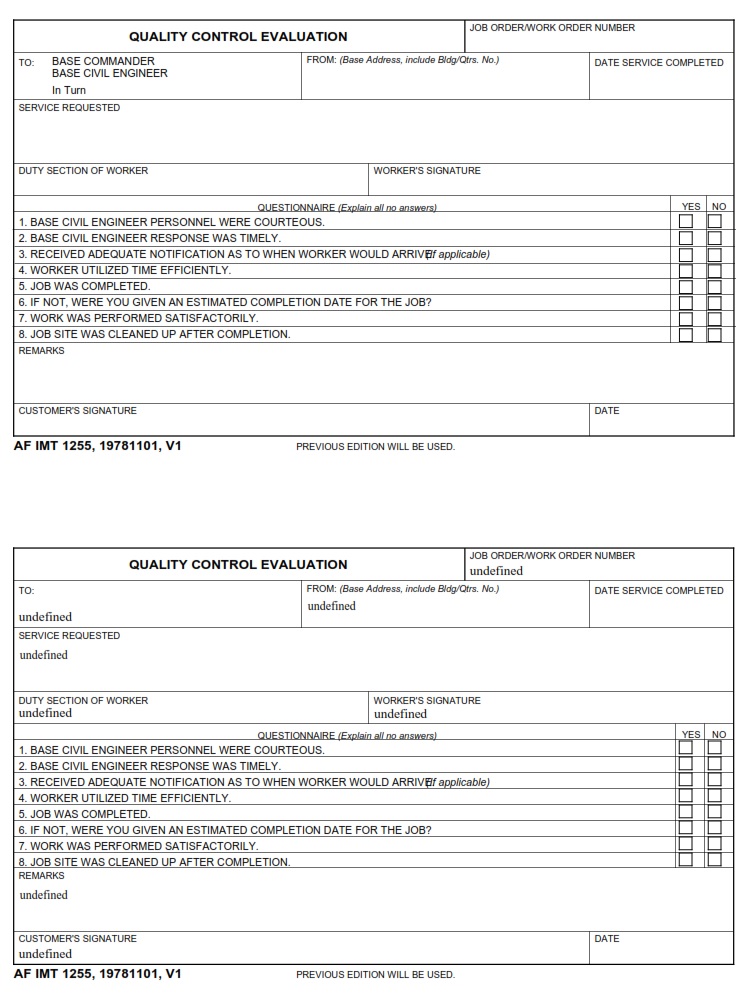AF-FORMS.COM – AF Form 1255 – Quality Control Evaluation – In the world of military aviation, precision and excellence are not just expected, but absolutely essential. Enter the AF Form 1255 – Quality Control Evaluation, a document that serves as the backbone of ensuring operational readiness and safety in the skies above. This seemingly innocuous form holds within its structured fields an intricate web of evaluations and assessments that can make all the difference between success and failure in high-stakes missions.
From scrutinizing maintenance procedures to assessing training protocols, the AF Form 1255 leaves no room for error or oversight. Every ticked box and filled-in blank represents a meticulous examination of every aspect of an aircraft’s functionality and crew performance. For those who live by the mantra precision equals perfection, this form is not just paperwork – it is a lifeline to maintaining peak operational efficiency amidst turbulent skies. Join us as we delve into the depths of this critical evaluation tool, unraveling its significance in safeguarding lives and upholding standards in aerial operations like never before.
Download AF Form 1255 – Quality Control Evaluation
| Form Number | AF Form 1255 – |
| Form Title | Quality Control Evaluation |
| Edition Date | 11/1/1978 |
| File Size | 33 KB |
AF-Form-1255-Quality-Control-Evaluation.pdf (28 downloads )
What is an AF Form 1255?
The AF Form 1255 serves as a critical tool in the Air Force’s Quality Control Evaluation process, providing detailed information on evaluations conducted for various functions within the organization. This form enables personnel to document and assess quality control processes, ensuring compliance with standards and identifying areas for improvement. By meticulously documenting evaluations using AF Form 1255, the Air Force can maintain high standards of quality and continuously enhance its operations.
One unique aspect of AF Form 1255 is its ability to streamline communication between different units and departments within the Air Force. This form serves as a central repository for quality control data, allowing for easy access and sharing of information across various levels of command. Additionally, by standardizing evaluation processes through AF Form 1255, the Air Force can promote consistency and transparency in its quality control practices, ultimately leading to improved efficiency and effectiveness within the organization.
Where Can I Find an AF Form 1255?
When it comes to finding an AF Form 1255, the first place to check is the official U.S. Air Force website. Here, you can access a digital version of the form for download or printing. Additionally, military supply offices on base or at installations may also have physical copies available for distribution.
For those who prefer a more convenient option, online platforms like forms outlets or document repositories often offer downloadable versions of AF Form 1255. It’s important to ensure that any form obtained from these sources is up-to-date and meets official Air Force requirements. Knowing where to find this form ensures smooth operations in quality control evaluations within the aviation industry and helps maintain compliance with regulations.
AF Form 1255 – Quality Control Evaluation
The AF Form 1255, also known as the Quality Control Evaluation form, plays a crucial role in ensuring the highest standards are maintained within the Air Force. This form serves as a documented record of evaluations conducted on various processes, procedures, and products to identify areas for improvement and ensure compliance with established quality control measures. By systematically evaluating performance against set criteria, the Quality Control Evaluation form helps in fostering a culture of continuous improvement and excellence within the organization.
One key aspect of the AF Form 1255 is its ability to provide valuable feedback for both individuals and teams involved in carrying out specific tasks or projects. Through detailed assessments and recommendations outlined in this form, personnel can gain insights into their strengths and areas needing development. This feedback loop not only enhances individual performance but also contributes to overall mission success by refining processes and enhancing quality assurance practices. By leveraging the information gathered from these evaluations, leaders can make informed decisions that drive operational effectiveness while promoting a culture of accountability and excellence within their units.
